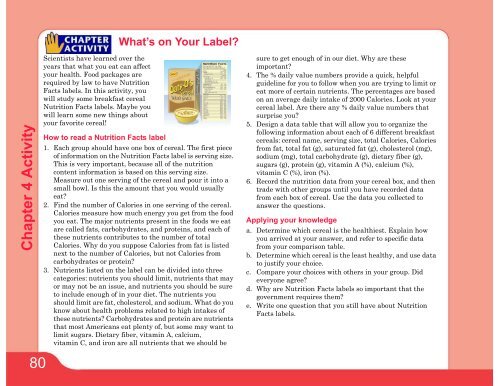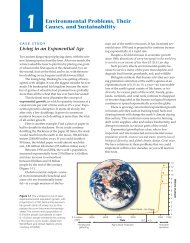Chapters 4 - Spokane Public Schools
Chapters 4 - Spokane Public Schools
Chapters 4 - Spokane Public Schools
Create successful ePaper yourself
Turn your PDF publications into a flip-book with our unique Google optimized e-Paper software.
Chapter 4 Activity<br />
Scientists have learned over the<br />
years that what you eat can affect<br />
your health. Food packages are<br />
required by law to have Nutrition<br />
Facts labels. In this activity, you<br />
will study some breakfast cereal<br />
Nutrition Facts labels. Maybe you<br />
will learn some new things about<br />
your favorite cereal!<br />
How to read a Nutrition Facts label<br />
What’s on Your Label<br />
1. Each group should have one box of cereal. The first piece<br />
of information on the Nutrition Facts label is serving size.<br />
This is very important, because all of the nutrition<br />
content information is based on this serving size.<br />
Measure out one serving of the cereal and pour it into a<br />
small bowl. Is this the amount that you would usually<br />
eat<br />
2. Find the number of Calories in one serving of the cereal.<br />
Calories measure how much energy you get from the food<br />
you eat. The major nutrients present in the foods we eat<br />
are called fats, carbohydrates, and proteins, and each of<br />
these nutrients contributes to the number of total<br />
Calories. Why do you suppose Calories from fat is listed<br />
next to the number of Calories, but not Calories from<br />
carbohydrates or protein<br />
3. Nutrients listed on the label can be divided into three<br />
categories: nutrients you should limit, nutrients that may<br />
or may not be an issue, and nutrients you should be sure<br />
to include enough of in your diet. The nutrients you<br />
should limit are fat, cholesterol, and sodium. What do you<br />
know about health problems related to high intakes of<br />
these nutrients Carbohydrates and protein are nutrients<br />
that most Americans eat plenty of, but some may want to<br />
limit sugars. Dietary fiber, vitamin A, calcium,<br />
vitamin C, and iron are all nutrients that we should be<br />
sure to get enough of in our diet. Why are these<br />
important<br />
4. The % daily value numbers provide a quick, helpful<br />
guideline for you to follow when you are trying to limit or<br />
eat more of certain nutrients. The percentages are based<br />
on an average daily intake of 2000 Calories. Look at your<br />
cereal label. Are there any % daily value numbers that<br />
surprise you<br />
5. Design a data table that will allow you to organize the<br />
following information about each of 6 different breakfast<br />
cereals: cereal name, serving size, total Calories, Calories<br />
from fat, total fat (g), saturated fat (g), cholesterol (mg),<br />
sodium (mg), total carbohydrate (g), dietary fiber (g),<br />
sugars (g), protein (g), vitamin A (%), calcium (%),<br />
vitamin C (%), iron (%).<br />
6. Record the nutrition data from your cereal box, and then<br />
trade with other groups until you have recorded data<br />
from each box of cereal. Use the data you collected to<br />
answer the questions.<br />
Applying your knowledge<br />
a. Determine which cereal is the healthiest. Explain how<br />
you arrived at your answer, and refer to specific data<br />
from your comparison table.<br />
b. Determine which cereal is the least healthy, and use data<br />
to justify your choice.<br />
c. Compare your choices with others in your group. Did<br />
everyone agree<br />
d. Why are Nutrition Facts labels so important that the<br />
government requires them<br />
e. Write one question that you still have about Nutrition<br />
Facts labels.<br />
80

















